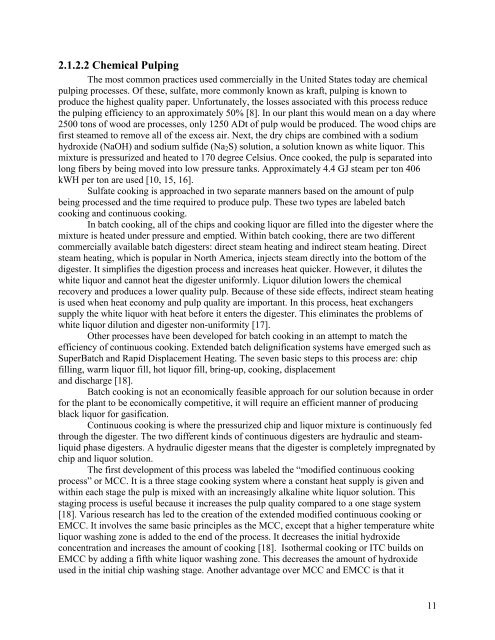Novel Design of an Integrated Pulp Mill Biorefinery for the ...
Novel Design of an Integrated Pulp Mill Biorefinery for the ...
Novel Design of an Integrated Pulp Mill Biorefinery for the ...
You also want an ePaper? Increase the reach of your titles
YUMPU automatically turns print PDFs into web optimized ePapers that Google loves.
2.1.2.2 Chemical <strong>Pulp</strong>ing<br />
The most common practices used commercially in <strong>the</strong> United States today are chemical<br />
pulping processes. Of <strong>the</strong>se, sulfate, more commonly known as kraft, pulping is known to<br />
produce <strong>the</strong> highest quality paper. Un<strong>for</strong>tunately, <strong>the</strong> losses associated with this process reduce<br />
<strong>the</strong> pulping efficiency to <strong>an</strong> approximately 50% [8]. In our pl<strong>an</strong>t this would me<strong>an</strong> on a day where<br />
2500 tons <strong>of</strong> wood are processes, only 1250 ADt <strong>of</strong> pulp would be produced. The wood chips are<br />
first steamed to remove all <strong>of</strong> <strong>the</strong> excess air. Next, <strong>the</strong> dry chips are combined with a sodium<br />
hydroxide (NaOH) <strong>an</strong>d sodium sulfide (Na2S) solution, a solution known as white liquor. This<br />
mixture is pressurized <strong>an</strong>d heated to 170 degree Celsius. Once cooked, <strong>the</strong> pulp is separated into<br />
long fibers by being moved into low pressure t<strong>an</strong>ks. Approximately 4.4 GJ steam per ton 406<br />
kWH per ton are used [10, 15, 16].<br />
Sulfate cooking is approached in two separate m<strong>an</strong>ners based on <strong>the</strong> amount <strong>of</strong> pulp<br />
being processed <strong>an</strong>d <strong>the</strong> time required to produce pulp. These two types are labeled batch<br />
cooking <strong>an</strong>d continuous cooking.<br />
In batch cooking, all <strong>of</strong> <strong>the</strong> chips <strong>an</strong>d cooking liquor are filled into <strong>the</strong> digester where <strong>the</strong><br />
mixture is heated under pressure <strong>an</strong>d emptied. Within batch cooking, <strong>the</strong>re are two different<br />
commercially available batch digesters: direct steam heating <strong>an</strong>d indirect steam heating. Direct<br />
steam heating, which is popular in North America, injects steam directly into <strong>the</strong> bottom <strong>of</strong> <strong>the</strong><br />
digester. It simplifies <strong>the</strong> digestion process <strong>an</strong>d increases heat quicker. However, it dilutes <strong>the</strong><br />
white liquor <strong>an</strong>d c<strong>an</strong>not heat <strong>the</strong> digester uni<strong>for</strong>mly. Liquor dilution lowers <strong>the</strong> chemical<br />
recovery <strong>an</strong>d produces a lower quality pulp. Because <strong>of</strong> <strong>the</strong>se side effects, indirect steam heating<br />
is used when heat economy <strong>an</strong>d pulp quality are import<strong>an</strong>t. In this process, heat exch<strong>an</strong>gers<br />
supply <strong>the</strong> white liquor with heat be<strong>for</strong>e it enters <strong>the</strong> digester. This eliminates <strong>the</strong> problems <strong>of</strong><br />
white liquor dilution <strong>an</strong>d digester non-uni<strong>for</strong>mity [17].<br />
O<strong>the</strong>r processes have been developed <strong>for</strong> batch cooking in <strong>an</strong> attempt to match <strong>the</strong><br />
efficiency <strong>of</strong> continuous cooking. Extended batch delignification systems have emerged such as<br />
SuperBatch <strong>an</strong>d Rapid Displacement Heating. The seven basic steps to this process are: chip<br />
filling, warm liquor fill, hot liquor fill, bring-up, cooking, displacement<br />
<strong>an</strong>d discharge [18].<br />
Batch cooking is not <strong>an</strong> economically feasible approach <strong>for</strong> our solution because in order<br />
<strong>for</strong> <strong>the</strong> pl<strong>an</strong>t to be economically competitive, it will require <strong>an</strong> efficient m<strong>an</strong>ner <strong>of</strong> producing<br />
black liquor <strong>for</strong> gasification.<br />
Continuous cooking is where <strong>the</strong> pressurized chip <strong>an</strong>d liquor mixture is continuously fed<br />
through <strong>the</strong> digester. The two different kinds <strong>of</strong> continuous digesters are hydraulic <strong>an</strong>d steamliquid<br />
phase digesters. A hydraulic digester me<strong>an</strong>s that <strong>the</strong> digester is completely impregnated by<br />
chip <strong>an</strong>d liquor solution.<br />
The first development <strong>of</strong> this process was labeled <strong>the</strong> “modified continuous cooking<br />
process” or MCC. It is a three stage cooking system where a const<strong>an</strong>t heat supply is given <strong>an</strong>d<br />
within each stage <strong>the</strong> pulp is mixed with <strong>an</strong> increasingly alkaline white liquor solution. This<br />
staging process is useful because it increases <strong>the</strong> pulp quality compared to a one stage system<br />
[18]. Various research has led to <strong>the</strong> creation <strong>of</strong> <strong>the</strong> extended modified continuous cooking or<br />
EMCC. It involves <strong>the</strong> same basic principles as <strong>the</strong> MCC, except that a higher temperature white<br />
liquor washing zone is added to <strong>the</strong> end <strong>of</strong> <strong>the</strong> process. It decreases <strong>the</strong> initial hydroxide<br />
concentration <strong>an</strong>d increases <strong>the</strong> amount <strong>of</strong> cooking [18]. Iso<strong>the</strong>rmal cooking or ITC builds on<br />
EMCC by adding a fifth white liquor washing zone. This decreases <strong>the</strong> amount <strong>of</strong> hydroxide<br />
used in <strong>the</strong> initial chip washing stage. Ano<strong>the</strong>r adv<strong>an</strong>tage over MCC <strong>an</strong>d EMCC is that it<br />
11

















